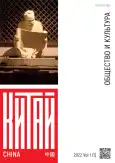Reign Symbols as a Source on Chinese History (Part 1)
- Authors: Deopik D.V.1, Ganshin B.K.1
-
Affiliations:
- Synology Center of Dmitry Pozharsky University
- Issue: Vol 1, No 1 (2022)
- Pages: 19-36
- Section: Articles
- URL: https://journal-vniispk.ru/China_SC/article/view/81799
- DOI: https://doi.org/10.17816/Ch81799
- ID: 81799
Cite item
Full Text
Abstract
This paper focuses on exploring the symbolical side of the China’s emperors’ reign names as the highest sacral generalizations. Reign symbol is pair of characters, which defines a reign of a monarch (or a part of the reign). The first character is a so-called “Attribute”, second is an “Object”. This paper raises the question whether the historical dynamics of these symbols’ change reflects the real changes of socio-political processes. This question is resolved through methods of quantitative analysis of the entire assembly of the reign names of all the centralized empires in the history of East Asia. Methodologically taking these symbols (reign names) as a system, as one hypertext, we categorized their meaning into groups (semantic categories). By studying the dynamics of these groups’ proportional change through the epochs of various Chinese empires, we came to the conclusion, that the symbolic dynamic of reign names reflects the change the properties of political ideology, changes in the religious politics, and political institutions. Reign names’ symbols can be used as a historical source on those topics.
Keywords
Full Text
##article.viewOnOriginalSite##About the authors
Dega V. Deopik
Synology Center of Dmitry Pozharsky University
Email: d.v.deopik@inbox.ru
Dr. Sci. (Hist.), Professor
Russian Federation, MoscowBogdan K. Ganshin
Synology Center of Dmitry Pozharsky University
Author for correspondence.
Email: bganshin@gmail.com
Russian Federation, Moscow
References
- Wang Yü-ch’üan. An Outline of The Central Government of The Former Han Dynasty. Harvard Journal of Asiatic Studies. 1949;12(1/2):134–187. doi: 10.2307/2718206
- Rybakov VM. The T’ang Bureaucracy. Pt 1. Genesis and Structure. Saint Petersburg: Peterburgskoe vostokovedenie; 2009. 512 p. P:451–457. (In Russ).
- Yang CK. Religion in Chinese Society: A Study of Contemporary Functions of Religion and Some of Their Historical Factors. Berkeley: University of California Press; 1961.
- Wang Xijia. Zhanxian zongjiao wenhua meili xuxie zhongri jiaoliu xinpian cong riben xin nianhao linghe tanqi [A New Discussion of Attractiveness of Religious Culture in Continuation of Chinese-Japanese Contacts from the Perspective of the New Japanese Era Name “Reiva”]. Zhongguo zongjiao. 2019;(4):10. (In Chinese).
- Schafer EH. Non-translation and Functional Translation: Two Sinological Maladies. The Journal of Asian Studies. 1954;13(3):251–260. doi: 10.2307/2942278
- Wright MC. What’s in a Reign Name: The Uses of History and Philology. The Journal of Asian Studies. 1958;18(1):103–106. doi: 10.2307/2941289
- Martynov AS. Era (Reign) Names of Chinese Emperors (Nian Hao). Proceedings of the 12th science conference «Written Monuments and Problems of the History of Culture of the East». Мoscow; 1977. P:78–84. (In Russ).
- Wechsler HJ. Offerings of Jade and Silks: Ritual and Symbol in the Legitimation of the T’ang Dynasty. New Haven (Conn.): Yale University Press; 1985.
- Rothschild NH. An Inquiry into Reign Era Changes under Wu Zhao, China’s Only Female Emperor. Early Medieval China. 2006;(1):123–149.
- Sun Yinggang. Wu nianhao yu gaizheng shuo: anshizhiluan zhong xiaozong chongsu zhengtong nuli – jian lun lifa yu zhonggu zhengzhizhi guanxi [Absence of the Reign Symbol and Change in Calendar: The Emperor Su Zong’s Efforts to Restore the Dynasty during the An Lushan’s Uprising and the Issue of Interconnectedness between Calendar and Politics in Ancient Times]. Renwen zazhi. 2013;(3). (In Chinese)
- Zhang Junfei. Cong nianhao kan shiliu guo zhengquanzhi wenhua yu zhengzhi quxiang [Certain political and cultural tendencies of the “Sixtheen barbarian states” within the context of reign symbols]. Jiangsu jiaoyu xuebao. 2007;(1). (In Chinese)
- Ma Xue. Liang song shiqi diwang nianhao manyi [Comments of the Chinese emperors’ reign symbols of the North and Southern Song]. Cangsang. 2008;(1). (In Chinese)
- Gao Hong. Riben queding «linghe» he «nianhao» guochengzhongde zhengzhi yinsu tanxi [Studies on political factors behind announcement of Japanese reign symbol “Reiva”]. Riben xuekan. 2019;(3). (In Chinese)
- Sima Qian. Istoricheskie zapiski (Shi ji). Vyatkin AR, Taskin VS, trans., comment. Moscow: Vostochnaya literatura; 2003;2. 567 p. P:277 (In Russ).
Supplementary files









